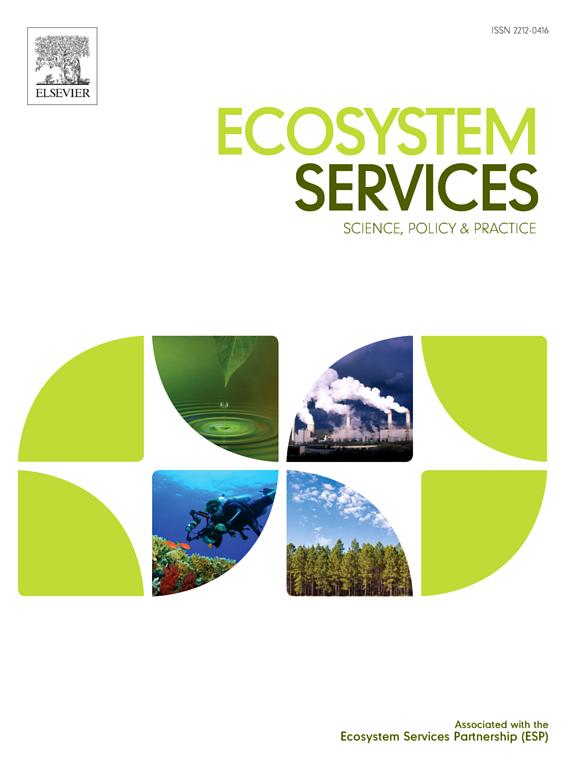将生态系统服务映射到可持续发展目标网络:将生态系统服务整合到可持续发展目标共同实现中的工具包
IF 6.6
2区 环境科学与生态学
Q1 ECOLOGY
引用次数: 0
摘要
生态系统服务对实现可持续发展目标有着不可忽视的贡献。然而,可持续发展目标之间的复杂权衡削弱了贡献。需要进一步探讨可持续发展企业对共同实现多个可持续发展目标的贡献。以黄土高原典型生态脆弱盆地为例,结合ESs供需和专家知识法估算了1990 - 2020年SDG1、2、6、15分值的变化。引入网络分析构建sdg网络,整合度中心性和紧密中心性,识别网络中高度重要的sdg。在不同的共享社会经济路径和代表性集中路径(ssps - rcp)情景下,模拟了2050年可持续发展目标网络的潜在变化。结果表明:产水量和固碳亏缺风险增大;4个sdg得分主要呈现先降后升的趋势,其中SDG6的变化最为剧烈。4个可持续发展目标得分变化之间的协同效应在北部盆地逐渐增强。节点重要性最高的SDG2、6子流域所占比例分别从18.75%和0%增加到26.67%和40.00%。SDG2,6对sdg评分变化之间协同效应的作用得到加强。四个可持续发展目标的得分在不同情景下普遍下降,其中可持续发展目标15的得分下降尤为显著。SSP1-RCP2.6情景的4个SDGs得分下降幅度最小。在大多数情景下,可持续发展目标15对可持续发展目标得分变化之间协同效应的作用最强。在SSP1-RCP2.6和SSP5-RCP8.5情景下,SDG15节点重要性最高的子流域占比超过58%。本研究通过将可再生能源供需整合到可持续发展目标网络分析中,试图构建一个将可再生能源整合到可持续发展目标共同实现中的工具包。本文章由计算机程序翻译,如有差异,请以英文原文为准。
Mapping ecosystem services to SDGs network: A toolkit to integrate ecosystem services into SDGs co-realization
Ecosystem services (ESs) have a non-negligible contribution to Sustainable Development Goals (SDGs) realization. However, the complex trade-offs between the SDGs undermine the contribution. The contribution of ESs to the multiple SDGs co-realization needs to be further explored. Taking a typical ecologically fragile basin in the Loess Plateau as an example, this study combined the ESs supply and demand with the expert knowledge method to estimate the changes of SDG1,2,6,15 scores from 1990 to 2020. Network analysis was introduced to construct the SDGs network, integrating degree centrality and closeness centrality to identify SDGs of high importance in the network. The potential changes of SDGs networks in 2050 were simulated under different shared socioeconomic pathways and representative concentration pathways (SSPs-RCPs) scenarios. The results showed that the deficit risk of water yield and carbon sequestration increased. The four SDGs scores mainly showed a trend of decreasing and then increasing, with SDG6 showing the most drastic change. The synergies among changes in the four SDGs scores gradually strengthened in the northern basin. The proportion of sub-basins with SDG2,6 as the highest Node Importance increased from 18.75% and 0% to 26.67% and 40.00%, respectively. The role of SDG2,6 on the synergies among changes in SDGs scores strengthened. The four SDGs scores generally decreased under the different scenarios, with a particularly significant decrease in SDG15. The SSP1-RCP2.6 scenario had the least decrease in the four SDGs scores. The role of SDG15 on the synergies among changes in SDGs scores was strongest under most scenarios. The proportion of sub-basins with SDG15 as the highest Node Importance accounted for more than 58% under SSP1-RCP2.6 and SSP5-RCP8.5 scenarios. By integrating ESs supply and demand into SDGs network analysis, this study attempted to construct a toolkit for integrating ESs into SDGs co-realization.
求助全文
通过发布文献求助,成功后即可免费获取论文全文。
去求助
来源期刊

Ecosystem Services
ECOLOGYENVIRONMENTAL SCIENCES&-ENVIRONMENTAL SCIENCES
CiteScore
14.90
自引率
7.90%
发文量
109
期刊介绍:
Ecosystem Services is an international, interdisciplinary journal that is associated with the Ecosystem Services Partnership (ESP). The journal is dedicated to exploring the science, policy, and practice related to ecosystem services, which are the various ways in which ecosystems contribute to human well-being, both directly and indirectly.
Ecosystem Services contributes to the broader goal of ensuring that the benefits of ecosystems are recognized, valued, and sustainably managed for the well-being of current and future generations. The journal serves as a platform for scholars, practitioners, policymakers, and other stakeholders to share their findings and insights, fostering collaboration and innovation in the field of ecosystem services.
 求助内容:
求助内容: 应助结果提醒方式:
应助结果提醒方式:


